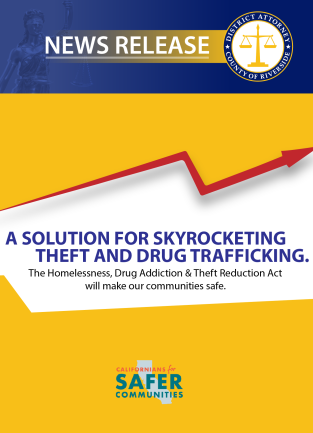Guest blog: Deputy DA Maureen DuMouchel provides important information about elder abuse
June 15, 2022

Guest blog: Deputy DA Maureen DuMouchel provides important information about elder abuse
Issues Facing Elderly Adults
Elder abuse can occur in many different situations. Some elder abuse cases are random and occur at the hands of strangers such as a random violent attack outside a grocery store, identity theft by a suspect stealing mail, or lottery scams through the mail. In these situations, the victim is chosen at random, often for no apparent reason. Sadly, most elder abuse cases involve an abuser who is very well known to the victim like an adult child, grandchild, family member, caregiver, friend, or roommate. In both types of cases, a victim may be reluctant to report the abuse due to embarrassment or fear. However, when a victim has a personal or familial relationship with the abuser, the victim is even more likely to not report the abuse -- which can keep the victim in an unsafe situation.
According to the California Department on Aging, the elderly population in Riverside County is expected to grow 200 percent by the year 2060. This dramatic increase means a greater number of elders will become crime victims and there will be a greater need for organizations that provide services and resources for older adults. Elders who have experienced abuse have a 300 percent higher risk of death when compared to those who have not been abused.[1] At least 10 percent of adults over 65 will experience some type of abuse in any given year, yet studies estimate most elder abuse is never reported. One such study found only 1 in 14 cases of elder abuse was ever reported to authorities. With the number of individuals over 65 years of age increasing significantly every year, elder abuse is a serious problem across the country.
How do we as a community tackle this growing problem? When it comes to elder abuse, knowledge is key. We need to learn the warning signs, spread the information to our older community members, and keep an eye out for our elderly neighbors who may be isolated and more easily victimized. Elder abuse is an issue that affects all of us, and, just like raising a family, it takes a village to help keep our more vulnerable older adults safe.
Types of Elder Abuse and Warning Signs
Physical Elder Abuse comes in many forms. There are many ways someone can physically abuse an elder: pushing, punching, slapping, throwing objects, burning, strangulation, or kicking. Other common forms of physical abuse specific to elder abuse include over-medicating or restraining the elderly with zip ties, rope, or duct tape. Physical abuse can also include using weapons, like firing a gun, using a knife in a stabbing, or harming a victim with ordinary household items like a hammer or glass bottle. The most common types of injuries we see from these cases will be bruising, black eyes, skin tears, broken bones or fractures, loss of consciousness, restraint marks, concussions, or injuries from a weapon.
Having prosecuted all types of elder abuse cases over the last five years, the most common types of physical abuse I have seen are injuries sustained when a caregiver, family member, or roommate physically harms the elder. Many times, the suspect is an individual suffering from mental health or substance abuse issues who lives with the elder, after everyone else in the family has refused to allow the suspect to live with them. This can create a very volatile and unpredictable situation that has the safety of the victim contingent on the suspect remaining calm and in control of their temper. Because of the familial relationship with the suspect, these victims may be victimized repeatedly without ever reaching out for help. It is vital to report every suspected case of physical abuse to law enforcement immediately so that they can provide immediate attention and resources where appropriate.
Neglect cases are broken down into two categories: self-neglect and caregiver neglect. For cases of self-neglect, an elderly victim may no longer be able to take care of his or her basic needs. As a result, they may not be taking their medication, managing their own finances, or doing daily activities such as bathing, cooking, or shopping for groceries. In situations like this, the elderly victim is at great risk for physical harm and financial exploitation. While these cases do not involve an outside suspect, it is still extremely important to contact appropriate authorities when you believe an elder is being neglected.
Caregiver neglect can involve the following signs: caregiver over/under medicating a victim to gain control and compliance; not administering medication properly; denial of food or water; lack of assistive devices like a walker, hearing aid, glasses, teeth, or phone; allowing a victim to sit in feces or urine; locking a victim inside a room; lack of rotating a bedbound elder which leads to bedsores or pressure ulcers being formed; and, failure to obtain proper and necessary medical treatment or follow-up. Whenever visiting an elder, look around to determine whether they have everything they need and that nothing appears unusual.
Isolation can be an indicator of elder abuse. Are family members being denied access to an aging client? Is a victim nervous around their caregiver or withdrawn and non-responsive? Does the caregiver restrict the victim’s communication with family and friends? Is a victim completely dependent upon their caregiver? Victims of abuse may be told lies by their abuser, which may poison the victim’s relationship with other family members. For example, the victim may believe and claim to other family members, “You only want to lock me in a home!” “You are only after my money!” “[Abuser] is the only person who cares and takes of me!” These kinds of claims may indicate signs the suspected abuser is isolating the victim.
Financial Abuse is extremely common among older adults. Most financial abuse cases I have prosecuted involve a trusted individual embezzling money from the victim’s accounts or convincing the victim to give them money based on a false pretense. Examples are cases where seniors are approached by trusted financial advisers encouraging wonderful “investment opportunities,” where no such investment exists, and the elder loses hundreds of thousands of dollars. Or a family member who holds power of attorney over the victim feels they are entitled to an early inheritance and begins to spend the elder’s money on themselves -- often leaving the elder destitute and unable to pay for their own expenses.
Typically, the victims of financial abuse cases are no longer familiar with their account status or log-in information. They may no longer be receiving mail as suspects will switch accounts to online banking. Whenever possible, seniors should be encouraged to continue reviewing their bank statements and account information, even if they have entrusted someone to manage their finances. Access to accounts does not automatically equal authorization to spend a victim’s money! Other warning signs to look out for include: a new name on the elder’s bank account signature cards, unauthorized withdrawals or transfers of money, purchases that do not benefit the victim, inappropriate financial reimbursement to caregiver, disappearance of funds or possessions, unpaid bills or changes in spending habits, and forged signatures on checks, loan documents, or grant deeds.
Another significant type of financial abuse comes from stranger scams. These types of financial scams occur over the phone, internet, and mail. Many victims never report the crimes committed against them because they may feel embarrassed or afraid. Never give any personal identifying information over the phone. When you do not recognize the caller, or if someone is pressuring you for account information, simply hang up the phone. Consider not answering phone calls from numbers you do not recognize. If they want to talk to you, they will leave a message. Don’t click on links that appear to be from your bank. A better practice is to call the bank and ask if the email is from them. Never give someone on the phone access to your computer information. Beware of individuals who claim you need to transfer or wire money to them, for any reason. And don’t forget the old saying, “If it sounds too good to be true, it probably is.”
Sexual Abuse is sadly another type of abuse that older adults can experience. This includes any unwanted, non-consensual, threatened or forced sexual behavior by a caregiver, relative, or strangers. Possible signs of abuse can include bruising or unexplained bleeding in the genital or breast area, difficulty walking or sitting, a bedbound victim found in a vulnerable position, unexplained sexually transmitted diseases, and depression or sudden changes in mood or emotions. Concerns of sexual abuse, or if you witness someone sexually abusing an older adult, it must be reported to law enforcement immediately by dialing 911.
How to Report Suspected Elder Abuse
Like the old saying goes, “If you see something, say something!” This is particularly true for elder abuse. There are many agencies that serve to protect elders. If you suspect someone is being abused, and a victim needs an emergency response, your first point of contact should be your local law enforcement agency where the crime has occurred or where the victim resides. Call 911 for an emergency response. If you want to file a report on a non-emergency situation, please contact your local law enforcement dispatch or non-emergency number.
Adult Protective Services provides services for seniors and investigates concerns of abuse or neglect involving seniors 60 years of age and older. Suspected abuse can be reported through the 24/7 hotline at (800) 491-7123 or online at www.reporttoaps.org.
The Long-term Care Ombudsman is responsible for providing services and overseeing the wellbeing of seniors in facilities. Concerns of abuse, neglect, or resident safety occurring within a facility can be reported to (833) 772-6624. The toll-free 24-hour hotline number is (800) 231-4024.
Local Resources Available for Seniors
Riverside County has a variety of resources for our senior population. There are numerous senior centers located in all parts of the county that offer activities, programming, and community gatherings. A link to these centers can be found at https://rivco.org/community/seniors-and-retirement.
As we approach the summer and rising temperatures, it’s important to remember older adults can be very susceptible to warmer weather. Riverside County, through Community Action Partnership, has approximately 68 cooling centers that will be open in various parts of the county throughout these next few months. To find a cooling center closest to you, please visit https://capriverside.org/cool-centers.
The Office on Aging offers more than 20 programs to promote a life of dignity, wellbeing, and independence for older adults. These services include nutrition and meal service, health insurance counseling, and a toll-free Senior Help Link hotline at (800) 510-2020. Their website is https://www.rcaging.org/.
For those older adults on Medicare, Senior Medicare Patrol is another excellent resource. This program is designed to assist Medicare beneficiaries and provide them with information to prevent, detect and report health care fraud and abuse. The toll-free number is (877) 808-2468 and their website is https://www.smpresource.org/.
----------------------------------------------------------------------------------
Our guest blog article author, Maureen DuMouchel, has been a Riverside County Deputy District Attorney for 15 years. The last five years, Maureen has been assigned to the Special Prosecutions Region handling elder abuse cases, including those involving physical, financial, or sexual abuse.
[1] Dong, X, Simon, M., Mendes de Leon, C., Fulmer, T., Beck, T., Hebert, L. (2009). Elder self-neglect and abuse and mortality risk in a community-dwelling population. Journal of the American Medical Association, 302(5), 517–526. doi: 10.1001/jama.2009.1109








